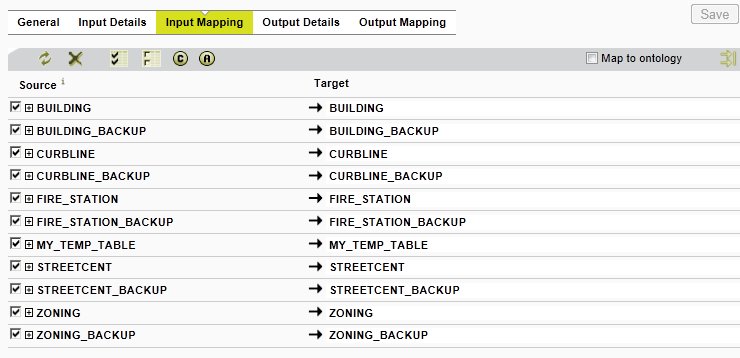Input mapping overview
Source and target maps are defined in the
tab. The map is organised into attributes within classes. 1Integrate supports
complex attributes such as arrays, references, and composite strings.
For example:

The Source column shows
the tables and columns from the schema for the external data source. Only
checked items are analysed in 1Integrate.
The Target column maps
tables and columns to classes and attributes in 1Integrate. You can override
the name and type of each attribute. By default, 1Integrate is populated
with the same names and data types as the external data source. 1Integrate
also indexes geometry columns and the primary keys of the source data.
Primary geometry
1Integrate allows you to map multiple geometries for a feature by selecting
Prm. When you import the data
into 1Integrate, you define the primary geometry. The primary geometry
is the column on which the spatial index is created in the cache, and
is always named geometry. The primary
geometry is reported in the rule conformance
report.
If there are no multiple geometries in your data, 1Integrate sets the
existing geometry column as the primary geometry. This setting will be
disabled.
Index flags
Each attribute has an Idx flag,
which determines whether or not the attribute is indexed by 1Integrate.
For optimum performance, index any attributes for which you want to define
rules that will search for objects with a specific value for that attribute.
To save time, it is recommended that you do not create an index for attributes
that will not be queried within a rule or action. By default, an index
is created within 1Integrate if one already exists in the external data
source.
Report flags
The Report option determines
whether or not an attribute is reported in the rule conformance results
XML and HTML
reports.
Updating input mappings
You can update the input mapping using the toolbar:
 |
Refresh
Reads the schema from the data source. If the current input
mapping is blank, it populates a default mapping using the same
class and property names as the external data source schema, with
all classes cleared. |
 |
Delete
all mappings
Returns the mapping to its default state. |
 |
Import
all classes and attributes
Selects every class and property. You can then clear the data
that is not required. |
 |
Clear
all selected classes and attributes for import
Clears every class and property. You must select at least
one attribute from one class to use data from this data store. |
 |
Add
target class
Create a class in the 1Integrate schema which is additional to
the source map. The additional class
might be used for temporary calculations or storage in rule and
action processing. A new class is always created with a primary
geometry column. The class may be written to the target data source,
if the class already exists in the external source. |
 |
Add
target attribute
Create an attribute, which is additional to the source map, on
a target class. The attribute may
be written to the target data source, if the attribute already
exists in the external source. |
 |
Select
ontology
Reads an OWL ontology that defines the internal schema to be used
within 1Integrate. |
